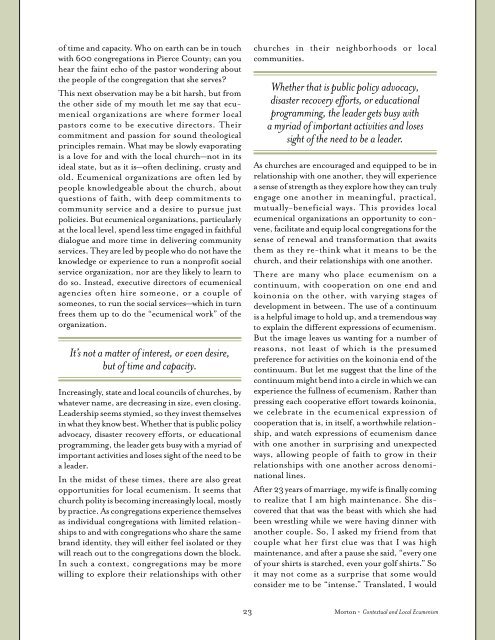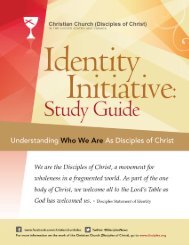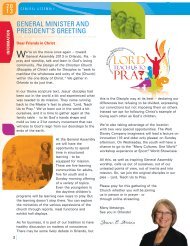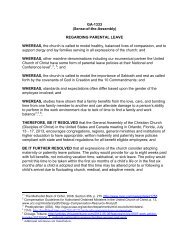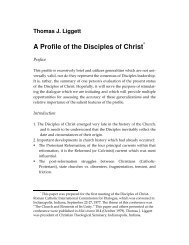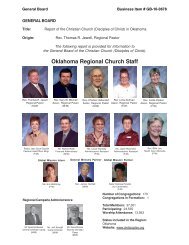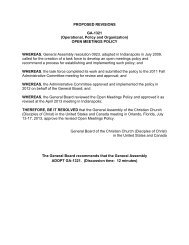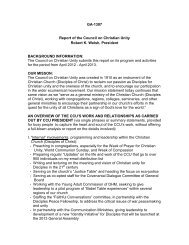RESOURCING THE CHURCH FOR ECUMENICAL MINISTRy A ...
RESOURCING THE CHURCH FOR ECUMENICAL MINISTRy A ...
RESOURCING THE CHURCH FOR ECUMENICAL MINISTRy A ...
Create successful ePaper yourself
Turn your PDF publications into a flip-book with our unique Google optimized e-Paper software.
of time and capacity. Who on earth can be in touch<br />
with 600 congregations in Pierce County; can you<br />
hear the faint echo of the pastor wondering about<br />
the people of the congregation that she serves?<br />
This next observation may be a bit harsh, but from<br />
the other side of my mouth let me say that ecumenical<br />
organizations are where former local<br />
pastors come to be executive directors. Their<br />
commitment and passion for sound theological<br />
principles remain. What may be slowly evaporating<br />
is a love for and with the local church—not in its<br />
ideal state, but as it is—often declining, crusty and<br />
old. Ecumenical organizations are often led by<br />
people knowledgeable about the church, about<br />
questions of faith, with deep commitments to<br />
community service and a desire to pursue just<br />
policies. But ecumenical organizations, particularly<br />
at the local level, spend less time engaged in faithful<br />
dialogue and more time in delivering community<br />
services. They are led by people who do not have the<br />
knowledge or experience to run a nonprofit social<br />
service organization, nor are they likely to learn to<br />
do so. Instead, executive directors of ecumenical<br />
agencies often hire someone, or a couple of<br />
someones, to run the social services—which in turn<br />
frees them up to do the “ecumenical work” of the<br />
organization.<br />
It’s not a matter of interest, or even desire,<br />
but of time and capacity.<br />
Increasingly, state and local councils of churches, by<br />
whatever name, are decreasing in size, even closing.<br />
Leadership seems stymied, so they invest themselves<br />
in what they know best. Whether that is public policy<br />
advocacy, disaster recovery efforts, or educational<br />
programming, the leader gets busy with a myriad of<br />
important activities and loses sight of the need to be<br />
a leader.<br />
In the midst of these times, there are also great<br />
opportunities for local ecumenism. It seems that<br />
church polity is becoming increasingly local, mostly<br />
by practice. As congregations experience themselves<br />
as individual congregations with limited relationships<br />
to and with congregations who share the same<br />
brand identity, they will either feel isolated or they<br />
will reach out to the congregations down the block.<br />
In such a context, congregations may be more<br />
willing to explore their relationships with other<br />
23<br />
churches in their neighborhoods or local<br />
communities.<br />
Whether that is public policy advocacy,<br />
disaster recovery efforts, or educational<br />
programming, the leader gets busy with<br />
a myriad of important activities and loses<br />
sight of the need to be a leader.<br />
As churches are encouraged and equipped to be in<br />
relationship with one another, they will experience<br />
a sense of strength as they explore how they can truly<br />
engage one another in meaningful, practical,<br />
mutually-beneficial ways. This provides local<br />
ecumenical organizations an opportunity to convene,<br />
facilitate and equip local congregations for the<br />
sense of renewal and transformation that awaits<br />
them as they re-think what it means to be the<br />
church, and their relationships with one another.<br />
There are many who place ecumenism on a<br />
continuum, with cooperation on one end and<br />
koinonia on the other, with varying stages of<br />
development in between. The use of a continuum<br />
is a helpful image to hold up, and a tremendous way<br />
to explain the different expressions of ecumenism.<br />
But the image leaves us wanting for a number of<br />
reasons, not least of which is the presumed<br />
preference for activities on the koinonia end of the<br />
continuum. But let me suggest that the line of the<br />
continuum might bend into a circle in which we can<br />
experience the fullness of ecumenism. Rather than<br />
pressing each cooperative effort towards koinonia,<br />
we celebrate in the ecumenical expression of<br />
cooperation that is, in itself, a worthwhile relationship,<br />
and watch expressions of ecumenism dance<br />
with one another in surprising and unexpected<br />
ways, allowing people of faith to grow in their<br />
relationships with one another across denominational<br />
lines.<br />
After 23 years of marriage, my wife is finally coming<br />
to realize that I am high maintenance. She discovered<br />
that that was the beast with which she had<br />
been wrestling while we were having dinner with<br />
another couple. So, I asked my friend from that<br />
couple what her first clue was that I was high<br />
maintenance, and after a pause she said, “every one<br />
of your shirts is starched, even your golf shirts.” So<br />
it may not come as a surprise that some would<br />
consider me to be “intense.” Translated, I would<br />
Morton • Contextual and Local Ecumenism


